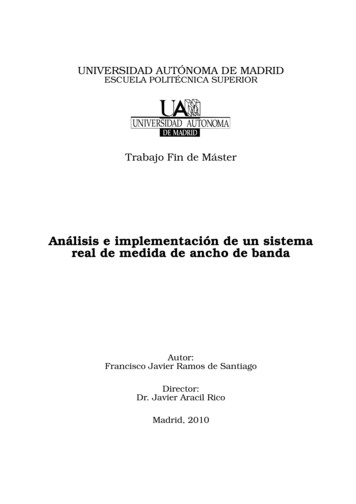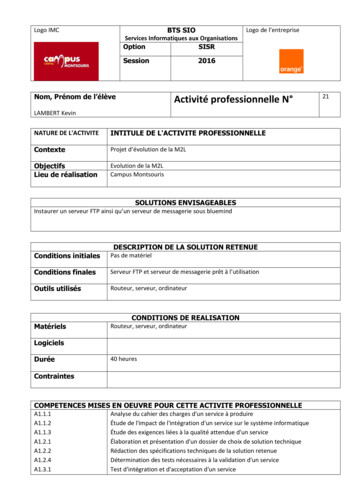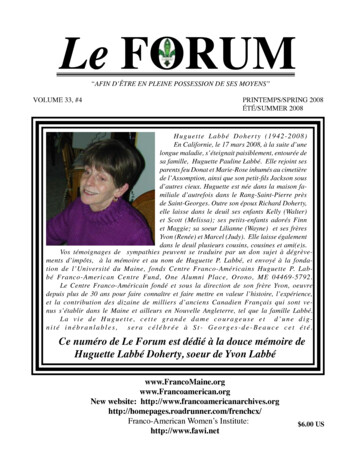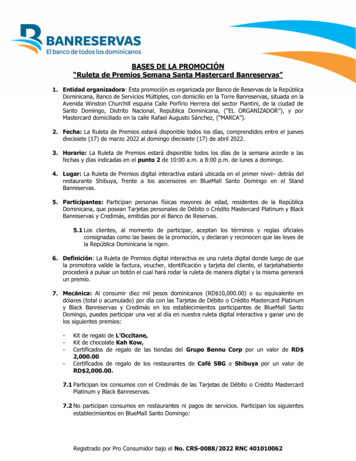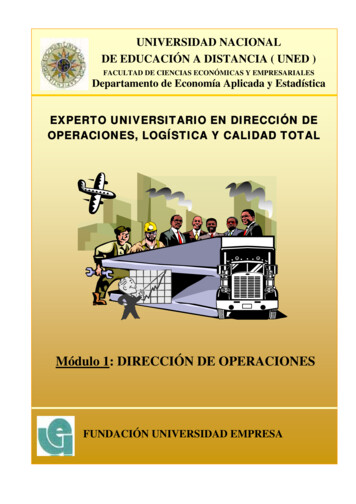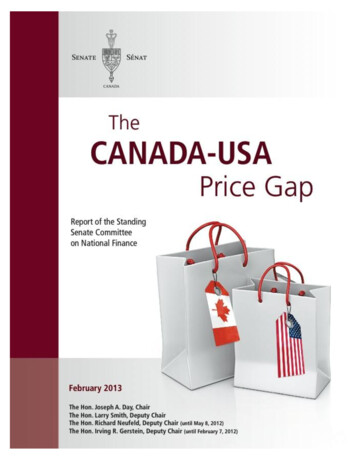
Transcription
0
Ce document est disponible en français.********Available on the Parliamentary Internet :www.parl.gc.ca41st Parliament – 1st Session
Table of ContentsMEMBERS OF THE COMMITTEE. iiiORDER OF REFERENCE . ivEXECUTIVE SUMMARY . viRECOMMENDATIONS / OBSERVATIONS . viiCHAPTER ONE: INTRODUCTION . 1CHAPTER TWO: EXCHANGE RATE. 2Factors that Influence the Exchange Rate . 2Move to Parity . 3Cross-Border Shopping and the Exchange Rate . 4CHAPTER THREE: REASONS FOR THE PRICE DISCREPANCIES . 6Country Pricing and Market Segmentation . 6Relative Size of the Canadian Market . 11Customs Tariffs. 13Assessing the impact of tariffs on the price paid by consumers . 16The majority of witnesses are calling for a comprehensive review of customs tariffs . 17Volatility of the Exchange Rate . 19Price Discrepancy in Fuel Costs for the Transportation Sector . 23Product Safety Standards . 26De minimis Threshold for Postal Shipments . 27CHAPTER FOUR: INDUSTRY STUDIES . 30Automobiles. 30Importing a vehicle into Canada: a good deal? . 36The significance of tariffs and safety requirements to the prices of automobiles and trucks 37Understanding automobile price discrepancies between Canada and the United States . 38Books . 41Online and e-books competition . 44The Copyright Act and the Regulatory Impact Analysis Statement . 46Magazines . 53i
CHAPTER FIVE: CHARGING WHAT THE MARKET WILL BEAR . 54The lack of competition in the Canadian retail market . 54Travellers’ Exemption Limits. 57Consumer awareness of web-based technology . 58CHAPTER SIX: CONCLUSION . 59APPENDIX A – WITNESSES WHO APPEARED BEFORE THE COMMITTEE . 60APPENDIX B – WRITTEN SUBMISSIONS RECEIVED WITHOUT THE AUTHOR’SAPPEARANCE . 65ii
MEMBERS OF THE COMMITTEEThe Honourable Joseph A. Day, Chair of the CommitteeThe Honourable Larry Smith, Deputy Chair of the CommitteeandThe Honourable Diane BellemareThe Honourable JoAnne L. ButhThe Honourable Catherine S. CallbeckThe Honourable Maria ChaputThe Honourable Pierre DeBané, P.C.The Honourable Doug FinleyThe Honourable Irving R. GersteinThe Honourable Céline Hervieux-Payette, P.C.The Honourable Thomas McInnisThe Honourable Nancy RuthEx-officio members of the Committee:The Honourable Senators Marjory LeBreton, P.C., (or Gérald Comeau) and James Cowan (orClaudette Tardif).Other Senators who have participated from time to time in the study:The Honourable Senators David Angus, Art Eggleton, P.C., Linda Frum, Leo Housakos, GhislainMaltais, Fabian Manning, Elizabeth Marshall, Yonah Martin, Percy Mockler, Grant Mitchell, RichardNeufeld, Pierre-Claude Nolin, Pierrette Ringuette, Michel Rivard, Bob Runciman, Carolyn StewartOlsen, Robert W. Peterson, John D. Wallace.Parliamentary Information and Research Service, Library of Parliament:Terrence Thomas and Édison Roy-César.Clerk of the Committee:Jodi TurnerSenate Committees Directorate:Louise Pronovost, Administrative Assistantiii
ORDER OF REFERENCEExtract from the Journals of the Senate of Thursday, December 13, 2012:The Honourable Senator Day moved, seconded by the Honourable Senator Moore:That, notwithstanding the order of the Senate adopted on Thursday, October 6, 2011, andMonday, June 11, 2012, the date for the presentation of the final report of the Standing SenateCommittee on National Finance on its study of the potential reasons for price discrepancies inrespect of certain goods between Canada and the United States, given the value of the Canadiandollar and the effect of cross border shopping on the Canadian economy, be extended fromDecember 31, 2012 to March 28, 2013; andThat the committee retain all powers necessary to publicize its findings until 90 days after thetabling of the final report.The question being put on the motion, it was adopted.Gary W. O’BrienClerk of the SenateExtract from the Journals of the Senate of Monday, June 11, 2012:With leave of the Senate,The Honourable Senator Day moved, seconded by the Honourable Senator Moore:That, notwithstanding the order of the Senate adopted on Thursday, October 6, 2011, the datefor the presentation of the final report of the Standing Senate Committee on National Finance on itsstudy of the potential reasons for price discrepancies in respect of certain goods between Canadaand the United States, given the value of the Canadian dollar and the effect of cross bordershopping on the Canadian economy, be extended from June 30, 2012 to December 31, 2012; andThat the committee retain all powers necessary to publicize its findings until 90 days after thetabling of the final report.After debate,The question being put on the motion, it was adopted.Gary W. O’BrienClerk of the Senateiv
Extract from the Journals of the Senate of Thursday, October 6, 2011:The Honourable Senator Gerstein moved, seconded by the Honourable Senator Martin:That the Standing Senate Committee on National Finance be authorized to examine and reporton the potential reasons for price discrepancies in respect of certain goods between Canada and theUnited States, given the value of the Canadian dollar and the effect of cross border shopping on theCanadian economy;That, in conducting such a study, the committee take particular note of differences betweenCanada and the United States including, but not limited to, market sizes, transportation costs, tariffrates, occupancy costs, labour costs, taxes and fees, regulations, mark-up; andThat the committee submit its final report to the Senate no later than June 30, 2012, and retainall powers necessary to publicize its findings for 180 days after the tabling of the final report.The question being put on the motion, it was adopted.Gary W. O’BrienClerk of the Senatev
EXECUTIVE SUMMARYIt is our sincere pleasure to present this final report of the Standing Senate Committee onNational Finance on the potential reasons for price discrepancies in respect of certain productsbetween Canada and the United States, given the value of the Canadian dollar and the effect ofcross-border shopping on the Canadian economy.When the Finance Committee undertook this study, we resolved to hear all perspectives inorder to develop a better understanding of this complex issue. We invited government officials,consumer groups, retailers, manufacturers, importers, exporters, experts from the academic sector,accountants and independent economists. Although not everyone we invited to appear before usaccepted our invitation, we did hear from witnesses in every category mentioned above, and thetestimony we heard shed light on the causes of price discrepancies between the two countries.The Committee examined the pricing of numerous products, from ice skates and jeans toautomobiles and books. Each product was found to have many factors influencing its pricing, and,although some products share some factors (e.g., transportation costs, the relative size of theCanadian market or tariff rates), the Committee cannot offer an explanation as definitive as it wouldhave liked for the price discrepancies for products between Canada and the United States.It is hoped that this report will improve Canadians’ knowledge of the causes of the pricediscrepancies for certain products between Canada and the United States, and will provide thefederal government with four recommendations to narrow these price discrepancies.Committee members are indebted to the staff of the Senate Committees Directorate and theLibrary of Parliament for helping to bring this report to fruition. We applaud their professionalism andcommitment to public service.Senator Joseph A. DayChairSenator Larry SmithDeputy Chairvi
RECOMMENDATIONS / OBSERVATIONSPlease note that these recommendations are best understood in thecontext of the reasoning presented in the body of the report. To locate thesection of the report relevant to each recommendation, please see thepage number in parentheses following the recommendation.The Standing Senate Committee on National Finance recommends the following:Recommendation 1:The Committee recommends that the Minister of Finance conduct acomprehensive review of Canadian tariffs, keeping in mind the impact ondomestic manufacturing, with the objective of reducing the price discrepanciesfor certain products between Canada and the United States. (page 19)Recommendation 2:The Committee recommends that the Government of Canada, through theCanada-United States Regulatory Cooperation Council, continue to integratethe safety standards between Canada and the United States with the intent toreduce the price discrepancies without compromising the safety needs of thetwo countries. (page 27)Recommendation 3:The Committee recommends that the Government of Canada analyse the costsand benefits of increasing the de minimis threshold for low-value shipments inCanada in order to narrow the price discrepancies for certain goods betweenCanada and the United States. (page 29)Recommendation 4:The Committee recommends that the Minister of Canadian Heritage study thecosts and benefits of reducing the 10% mark-up that Canadian exclusivedistributors can add to the U.S. list price of American books imported intoCanada, adjusted for the exchange rate, as stipulated in section 5(1)(a)(iii) ofthe Book Importation Regulations. (page 53)vii
Observation 1:As more Canadian consumers become aware of smartphone applications andInternet sites for price shopping and comparison, and become price-savvyconsumers, competitive pressures in Canada will increase and the price forproducts in Canada will converge to U.S. prices (page 59).viii
CHAPTER ONE: INTRODUCTIONCanadian consumers are feeling ripped off. When the Canadian dollar is at parity with theU.S. dollar, Canadian consumers notice that prices here are typically higher than in the UnitedStates. When buying books or magazines, they notice two prices on the covers, and usually theprice in Canada is higher. Numerous newspaper articles point out that list prices of many identicalautomobiles are thousands of dollars higher in Canada than in the United States. When Canadianswindow-shop, on a visit to the United States or online, they notice price gaps, especially on brandname goods, from Aspirin to running shoes.Naturally, Canadians wonder why these price gaps exist when the dollar is at parity, andwonder: “Are we being gouged?”In light of these concerns, the Minister of Finance wrote to the Chair and Deputy-chair of theStanding Senate Committee on National Finance and asked that the Committee study pricediscrepancies for certain products between Canada and the United States. On 6 October 2011, theSenate referred the following mandate to this committee:Study the potential reasons for price discrepancies in respect of certain goods betweenCanada and the United States, given the value of the Canadian dollar and the effect ofcross-border shopping on the Canadian economy.The committee held meetings from October 2011 to June 2012 and heard from 53 witnesses;information on the meetings and the witnesses is in Appendix A at the end of this report. Appendix Bcontains written submissions received without the appearance of the author.This report focuses on goods, not services. Services, it was felt, could be harder to compare– the "apples and oranges" problem – although, as will be seen below, the comparison of goods isnot always straightforward. The goods studied are associated with the manufacturing and retailsectors; supply-managed goods, which include eggs, poultry and dairy products, are associated withthe agricultural sector and were not part of this study.This report first examines aspects of the exchange rate between the two currencies,including the recent move to parity, the volatility and the influence of movements of the exchangerate on cross-border shopping. The report then examines the impact of country pricing and marketsegmentation, the relative size of the Canadian market, customs tariffs, the volatility of the exchangerate, the price of fuel, product safety standards, the de minimis threshold for postal shipments andthe level of competition on the price discrepancies for certain products between Canada and the1
United States. An important, if less than satisfying, finding is that there is no single explanation forthe price differences between the two countries.The report ends with three major sections: automobiles, books, and charging what themarket will bear. The first two sections look into sectors that have attracted considerable attentionregarding price gaps between list prices in Canada and in the United States. The last major sectionexamines whether the government should intervene, perhaps using the Competition Act, if theCanadian price for a specific product is out of line with the price of that product in the United States.CHAPTER TWO: EXCHANGE RATEIn June 1970, Canada stopped operating under a fixed exchange rate system, which set thevalue of one Canadian dollar at US 0.925 and returned to a flexible exchange rate system.1Under Canada’s flexible exchange rate system, the value of the Canadian dollar comparedto the U.S. dollar – or any other currency, for that matter – is based on the rules of supply anddemand. Any factor that increases (or decreases) demand for Canadian dollars, or decreases (orincreases) demand for a foreign currency, pushes the exchange rate upward (or downward).Factors that Influence the Exchange RateEconomic theory and empirical data have shed light on factors known to influence exchangerate movements (e.g., world prices for commodities, relative inflation rates, relative interest rates,productivity differences between countries, and short-term capital flows).2 In isolation, these factorshave a predictable effect on currency values.However, because many economic variables are closely interconnected, they rarely, if ever,act separately from one another. This makes anticipating or explaining movements in short-termexchange rates notoriously difficult, a problem exacerbated by the fact that many factors known toaffect currency values are evident only in hindsight. Furthermore, these factors are often themselvesaffected by movements in exchange rates. In other words, while the Canadian dollar responds toprevailing economic conditions, it influences those conditions as well.31Canada also operated under a flexible exchange rate system from 1950 to 1962; it was the only major industrialcountry to do so during this period.2Bank of Canada, Backgrounders, The Exchange Rate, 11/exchange rate.pdf.3Michael Holden, Explaining the Rise in the Canadian Dollar, Publication no. 03-26E, Parliamentary Informationand Research Service, Library of Parliament, Ottawa, 22 November 2007, p. ations/prb0326-e.pdf.2
Move to ParityFrom February 2002 to October 2007, the value of the Canadian dollar rose from a recordlow of US 0.62 to US 1.06 as a result of rising commodity prices and surging demand for Canadianexports.Responding to the financial crisis of 2008, international investors sold some of their assetsdenominated in Canadian dollars and other major currencies to buy U.S. assets, mainly dollars andgovernment bonds, considered the safest assets during crises because of the status of the dollar asthe world’s reserve currency. Consequently, the Canadian dollar fell from US 1.01 in May 2008 toUS 0.79 in March 2009.However, this downward trend was reversed in late 2009 because of rising commodity pricescaused by strong economic growth in emerging countries, strong demand for Canadian exports andhigher demand for Canadian assets by international investors, given Canada’s sound fiscal positionand the resilience and stability of the Canadian financial system during the financial crisis. All thesefactors pushed up the Canadian dollar, from US 0.79 in March 2009 to US 1.01 in December 2010.The Canadian dollar remained at or near parity since then.Figure 1 - Exchange Rate between the Canadian Dollar and the U.S. Dollar,January 2000 to March 2012US /CAN 000.00Source: Figure prepared by the Parliamentary Information and Research Service of the Library of Parliament using datafrom Statistics Canada, CANSIM, Table 176-0064.3
Cross-Border Shopping and the Exchange RateIn 2011, an average of 3.4 million Canadian travelers crossed the border into the UnitedStates by automobile each month, including 2.4 million Canadian travelers (69.7% of all Canadiantravellers) who made same-day trips.4Despite the United States population being about ten times the size of Canada’s population,the monthly average number of American travelers to Canada by automobile was only 1.1 million in2011.According to the authors of a recent university study titled Consumer Arbitrage Across aPorous Border, most Canadians travel to the United States by automobile for pleasure or personalreasons, which includes shopping trips.5 As shown in Figure 2, 64.6% of Canadian travelers crossthe border for pleasure or personal reasons, 22.2% to visit friends or relatives, 7.5% for businessaffairs, 5.5% for other reasons.Figure 2 – Reasons for Crossing the Border, 24-Hour Trip, 1990-20105.5%0.2%Business Affairs (7.5%)7.5%Visit friends or relatives (22.2%)22.2%Pleasure or personal trip (64.6%)64.6%Other (5.5%)Not stated (0.2%)Source: Ambarish Chandra, Keith Head, Mariano Tappata, Consumer Arbitrage Across a Porous Border, December 2011,p. 4, s.pdf.4Statistics Canada, CANSIM, Table 427-0005.5Ambarish Chandra, Keith Head, Mariano Tappata, Consumer Arbitrage Across a Porous Border, December 2011,p. 4, gs/pdf.4
Because Canadian travellers who go to the United States by automobile for pleasure orpersonal reasons are potentially the most likely to respond to the movements in the exchange rateand because they represent the majority of all Canadian travellers, the total number of Canadianstravelling to the United States by automobile should fluctuate with the movements of the exchangerate.Figure 3 confirms this. For example, when the exchange rate increased by 58.7% fromUS 0.63 in January 2002 to US 1.00 in January 2011, the monthly number of Canadian travellersreturning from the United States by automobile increased by 32.8%, from 2.5 million to 3.3 million.During the same period, the monthly number of American travellers returning to the United Statesfrom Canada by automobile decreased by 58.6%, from 2.7 million to 1.1 million.Interestingly, the monthly number of American travellers returning from Canada byautomobile was higher than the monthly number of Canadian travellers returning from the UnitedStates during the January 2000-to-May 2003 period, when the exchange rate between the Canadiandollar and the U.S. dollar was below US 0.74. When the value of the Canadian dollar reached atrough of US 0.63 in March 2002, the number of American travellers exceeded the number ofCanadian travellers by more than 525,000 people per month.Figure 3 – Cross-Border Shopping and the Exchange Rate, Monthly Number of CanadianTravellers and American Travellers by Automobile, January 2000 to February 2012CAN / US 10.00Aug-000Jan-00millions of people3.5Canadian travellers returning from the United States by automobileUnited States travellers entering Canada by automobileExchange Rate5
Source: Figure prepared by the Parliamentary Information and Research Service of the Library of Parliament using datafrom Statistics Canada, CANSIM, Table 427-0005 and Table 176-0064.Canadian travellers returning from the United States may bring back goods and they mayalso return with a sense of the relative prices of goods sold on both sides of the border. Butobservations on prices may be misleading, as actual transaction prices are needed to make usefulshopping comparisons. A Canadian who buys a product in the United States may remember the listprice of that product in Canada, but this recollected price may ignore possible discounts or saleprices available in Canada.Moreover, what appears to be the same product offered for sale in Canada and the UnitedStates might not be the same. Professor Tony Hernandez, Director of the Centre for the Study ofCommercial Activity (CSCA), Eaton Chair in Retailing, Ryerson University, offered the Committeeanecdotal evidence that 80% of the products in factory outlets were manufactured specifically forthose stores. This makes price comparisons difficult, as two brand-name shirts, for example, maybe made of different quality cotton and are, in effect, different goods.In addition to actual trips to the United States, Canadians can now make virtual trips to theUnited States and other countries via the Internet. Canadians use the Internet to shop and towindow-shop. In 2010, according to a survey by Statistics Canada, more than half of CanadianInternet users shopped online, placing 114 million orders valued at 15.3 billion.6The e-retailers from whom the Canadian online shoppers purchase goods represent acompetitive threat – and a growing one – to traditional Canadian retailers. This report does notattempt a full analysis of the cross-border online shopping. Online shopping is mentioned later on insections dealing with the de minimus threshold for postal shipments and with books.CHAPTER THREE: REASONS FOR THE PRICE DISCREPANCIESCountry Pricing and Market SegmentationFour witnesses told the Committee that the segmentation of the Canadian and the Americanmarkets could allow some manufacturers to practice country pricing — that is, to maximize profitsby selling their products at different prices in the two markets.The segmentation of the Canadian and American markets refers to the different commercialpractices, government regulations and all other factors that prevent Canadians and Americans from6Statistics Canada, Individual Internet use and E-commerce, 2010, The Daily, 12 October 12/dq111012a-eng.htm.6
eliminating price differences by purchasing goods that are cheaper in a country to sell them in theother country until the prices for goods in both countries converge.Ambarish Chandra, Professor, University of Toronto, Rotman School of Management,explained how the segmentation of the Canadian and American markets allows manufacturers toprice identical goods differently in the two markets:For example, Transport Canada has regulations over and above what U.S.specifications of cars are. Also, and this is something that is just coming out of ourresearch, U.S. manufacturers are not transferring warranties any longer forCanadians who buy cars in the U.S. and bring them back. I am not surprisedbecause they like to see this situation of segmented markets. They like to be able toprice products differently in different markets. All the theories suggest that is exactlywhat is profit maximizing for them. Cars are problematic because we have this issueof warranties, and if firms want to segment the market, they can do so. It is hard forgovernment or public policy to change that.7Ambarish Chandra, Professor, University of Toronto,Rotman School of Management, as an individualRegarding country pricing, a representative from the Retail Council of Canada explained tothe Committee that some manufacturers charge Canadian retailers 10% to 50% more than U.S.retailers for identical products. According to the Retail Council of Canada, its members were told bymanufacturers that there are three main reasons for these discrepancies: 1) Canadians are used topaying more for products in Canada; 2) the higher prices charged to retailers in Canada subsidizethe costs of maintaining suppliers offices and operations in Canada; and 3) the higher prices arenecessary to compensate Canadian distributors and wholesalers, which face higher costs inCanada.The Retail Council of Canada then added that not all manufacturers charge more toCanadian retailers than U.S. retailers for identical products, but the manufacturers that carryrecognized brands and thus have significant market power for their brands:If I am a sporting goods retailer in this country and I do not carry Reebok or Nike,chances are that I will not have too much retail traffic in my store. God bless thosemanufacturers because they have built that brand recognition. That explains 1/nffn/pdf/07issue.pdf, p. 7:36.7
they also sometimes have the ability to tell a Canadian retailer or a subsidiary of aNorth American retailer how much they will sell a product for if the retailer wants it intheir store.8Diane J. Brisebois, President and Chief Executive Officer,Retail Council of CanadaOne observation that can be drawn from this testimony is the importance ofrecognized brands on a manufacturer’s pricing. If some consumers want a particular brand ofa product, they increase the ability of the manufacturer of that brand to price its productdifferently in Canada and the United States, based on the demand.The Retail Council of Canada presented a list of 15 identical consumer products that showswhat Canadian retailers must pay their suppliers compared with U.S. retailers. As shown in Table 1,retailers pay anywhere between 11% more than U.S. retailers for an electric toothbrush to as muchas 114% more for products such as a pack of low-dose Aspirin.Given the discrepancies between the prices paid by Canadian and U.S. retailers for identicalproducts, the Retail Council of Canada argued that it was unfair to blame retailers for not adjustingtheir retail prices to account for the higher Canadian dollar. According to the Retail Council ofCanada, the majority of products purchased by Canadian retailers are bought in Canadian dollarsthrough Canadian distributors, wholesalers and headquarters of multinational companies in Canada.Consequently, the retail prices can adjust to the appreciation of the Canadian dollar only if themanufacturers, the wholesalers and the distributors change the price they charge to ttee/411/nffn/pdf/16issue.pdf, p. 16:11.8
Table 1 – Price paid by the Canadian and U.S. retailers for 15 identical consumer productsItem DescriptionPrice paid byPrice paid byU.S. RetailersCanadianDifferenceRetailersSoap – 16 pk 6.99 8.9828%Shampoo – 1.5LConditioner – 1.18LAutomobile Tires46in LED TVPrinterWater Filters – 6 pkCoffee MakerElectric ToothbrushIbuprophen 200mg – 250ctAspirin 81mg low dose – 350ctKetchup – 2.5 LFreezer bags– 150 pkLaundry Detergent – 5LOrange Juice – 7.56L 9.33 6.23 128.21 888.75 116.65 22.77 127.76 91.29 10.76 10.16 3.92 6.10 11.27 10.01 12.46 10.00 169.69 1,001.00 171.99 26.76 167.19 100.99 18.29 21.78 6.90 9.24 13.94 12.6634%61%3
The Honourable Larry Smith, Deputy Chair of the Committee and The Honourable Diane Bellemare The Honourable JoAnne L. Buth The Honourable Catherine S. Callbeck The Honourable Maria Chaput The Honourable Pierre DeBané, P.C. The Honourable Doug Finley The Honourable Irving R. Gerstein The Honourable Céline Hervieux-Payette, P.C.
